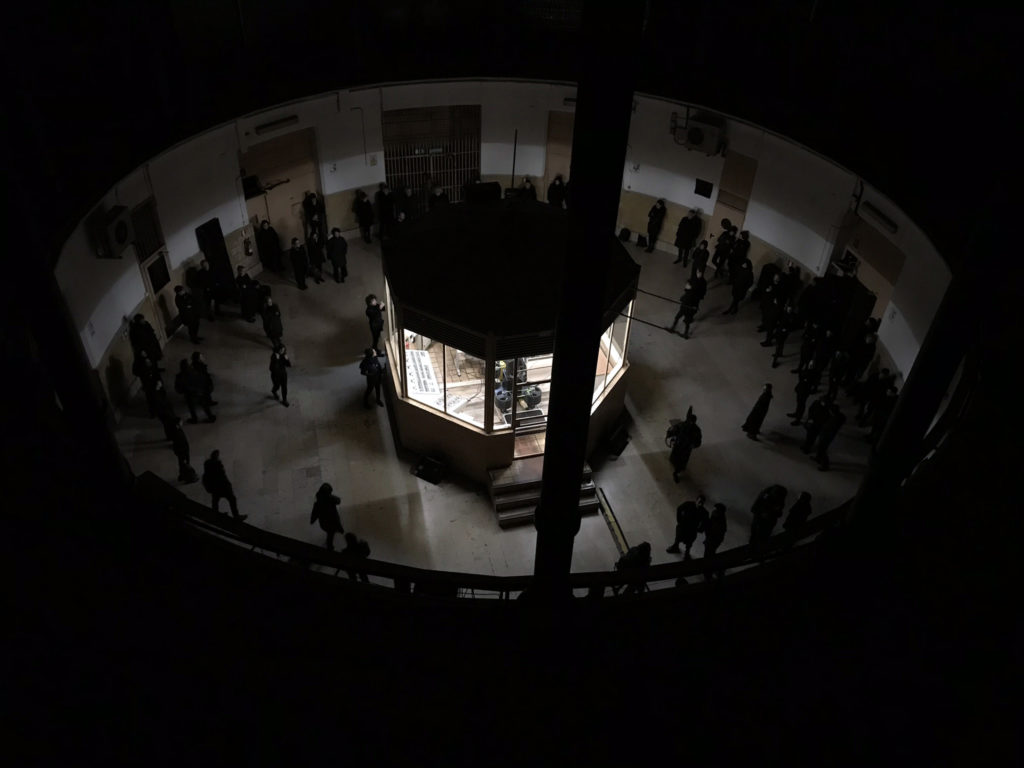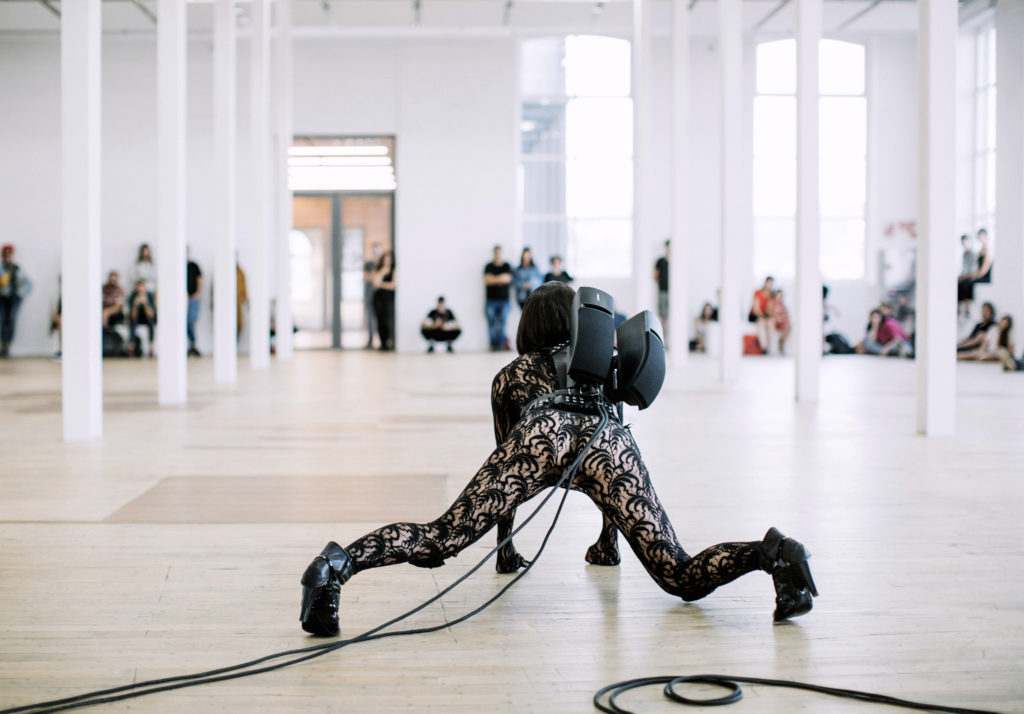
Since the late 1990s, Joan Morey has produced an expansive body of live events, videos, installations, sound, and graphic works that has explored the intersection of theater, cinema, philosophy, sexuality, and subjectivity. His practice brings together three vitally important genres of contemporary art: performance, appropriation, and institutional critique. Morey draws on a rhetoric of staging, roles, props, costumes, scripts, and spoken word. The artist is rarely an interpreter in his own work—yet, Morey stipulates characteristically rigid rules and uncompromising instructions that govern the formal parameters of what performers do (or have done to them), often extending how the audience experiences his works and the precise manner of their documentation. Morey’s creation of art through the strict control of its production, reproduction, and reception leads to his implication as both an author and an authority in a highly convoluted way.
Morey’s work both critiques and embodies one of the most thorny and far-reaching aspects of human consciousness and behavior: how we relate to others, as the oppressed or the oppressor. This central preoccupation with the exercise of power and authority seemingly accounts for the black and ominous tenor of his art. We might simply say Morey holds a mirror up to a world history that has been shaped by dominance and exploitation, as well as the numerous inequalities of the present. Yet, the work also suggests that it is precisely through the perverse collapsing of severity with sensuality, reality with imagination, degradation with desire, that— under exceptional circumstances—light can emerge from so much darkness. In the realm of these glimmers and shadows, Morey’s participates in a growing dramatis personæ of authorities, accomplices, and workers from different disciplines—from public figures such as marginal theorists or dramatists, to the bodies in space and time that realize and witness his works, or the private lives of known or anonymous persons: maybe you, or us.
In an exhibition and performance project that spanned three venues in Barcelona, Spain, recently curated by Latitudes in 2018–19, Joan Morey. COLLAPSE traced an overview of the last fifteen years of the artist’s practice. The exhibition, entitled Desiring Machine, Working Machine, installed at the Centre d’Art Contemporani de Barcelona—Fabra i Coats, documented ten projects by the artist including IL LINGUAGGIO DEL CORPO [The Language of the Body] (2015), developed at the Royal Academy of Spain in Rome, alongside a continuous program of audio works and a schedule of live performance extracts. The concluding segment, entitled Schizophrenic Machine, was comprised of a major new site-specific performance set in a former prison in Barcelona, which continued Morey’s long-standing exploration of power structures and control of the body.
Morey has often stated that his work hinges on a relationship between the concept of master-slave from the philosophy of G.W.F. Hegel and the practices of BDSM. Although Hegel does not discuss actual slavery in The Phenomenology of Spirit (1807), he offers an account of domination through a history of consciousness. The initialism refers to sadomasochism (SM), combined with other erotic practices and role-play involving bondage, discipline, dominance, and submission. Morey draws on the aesthetics and corporeal drama of this subculture in his projects, yet shows that, rather than a kind of aberrant corner of sex work, it has always been a form of political performance art, where masquerade and ceremony have turned dark and darker.
Morey has a predilection for absorbing scripted works from the stage or screen into his art (including texts from Samuel Beckett and Antonin Artaud, to Pier Paolo Pasolini and Ingmar Bergman), and his engagement with specific histories of contemporary art itself is revealing. The making of art through strict instructions, self-imposed constraints, or severe behavioral rules has been a trait of minimal and conceptual art since the 1960s. Choreographer Yvonne Rainer wrote rules to strip back dance to its bare essentials (No Manifesto, 1965), while between 1967 and 1969 Bruce Nauman made several films of himself performing monotonous actions, like prison-yard exercises. Morey emphasizes an undervalued masochistic inclination to this minimal art-asaskesis, not least through references to Nauman and Rainer. The libertine novelist Leopold von Sacher-Masoch, from whom masochism takes its name, was the first to argue that the essence of masochism is neither its affinity between pleasure and pain nor its roles of domination or subjugation, but its contractual relation—in other words, the granting of consent. This contract of consensual submission and domination invests masochism with defined roles that already form a dramatic narrative; and in Morey’s performances, the audience is also a signatory.
Morey’s explorations in contemporary art critique, or actually bring into being, what has seemed impossible throughout history: pure experience without concession to dominant ideologies and patterns of human behavior. Throughout the artist’s projects, we find both the essentially modern will to celebrate order and closure, and the impulse towards irrationality, temporality, and fragmentation.
I. COLLAPSE
POSTMORTEM. POUR EN FINIR AVEC LE JUGEMENT DE DIEU, 2006–2007.
POSTMORTEM originally took place in a large coffin-shaped stage, in which seven distinct performance “panels” presented masochistic and confrontational scenarios, including those that the artist has termed “subordination exercises.” In this extract, a female performer wears a black skin-tight garment and a loudspeaker that plays excerpts from To have done with the judgment of God (1947) by Antonin Artaud. Prowling around the gallery, the performer became a cat-like body burdened by a device that amplifies Artaud’s radio play, and its palpable obsession with the misery of existence.
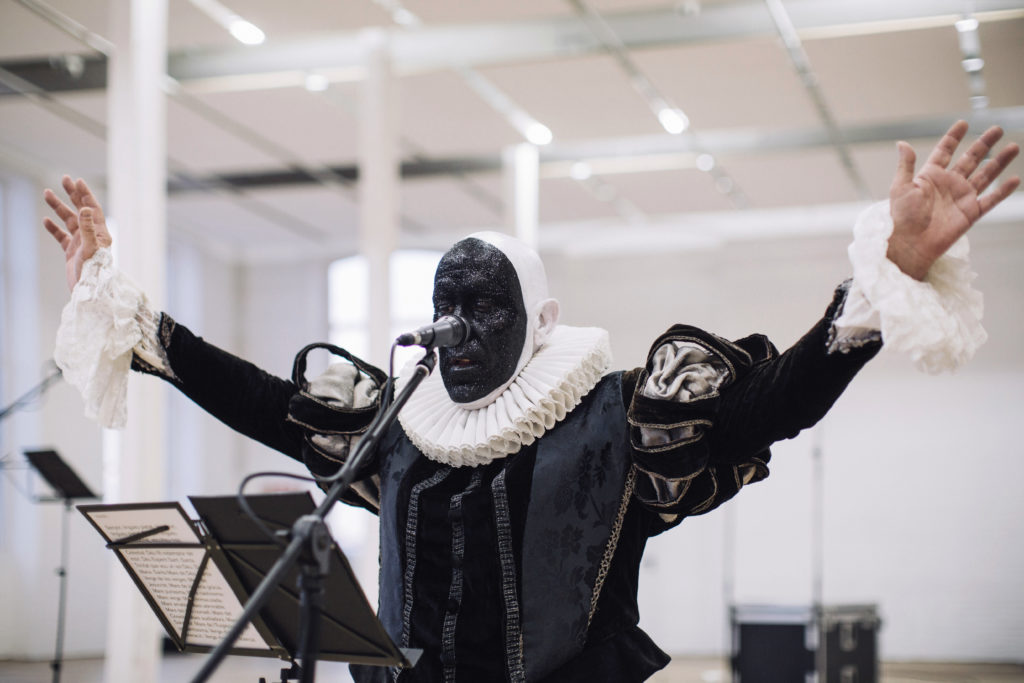
LLETANIA APÒRIMA [APORIC LITANY] (2009)
This dramatized, repetitive oration takes the form of a litany of obedience, anguish, and regret, delivered in Catalan by an inscrutable priest-courtier character wearing a distinctive neck ruff. Conventionally, a litany takes the form of a series of set invocations recited by a priest that alternate with the invariable responses of the congregation. Yet here, the script leaves no room for reply: the voice sounds more like a conflicted interior monologue, in which piety is infused with profanity. The performance includes the full version of a text from GRITOS Y SUSURROS. Converses amb els radicals [CRIES & WHISPERS: Conversations with Radicals], Morey’s 2009 performance series which shares its title with a 1972 film by Ingmar Bergman. This work similarly explores dark metaphors for Christian allegory and remorselessly bleak themes of physical and psychic suffering through visually arresting set pieces and a palette of black, white, and blood red.
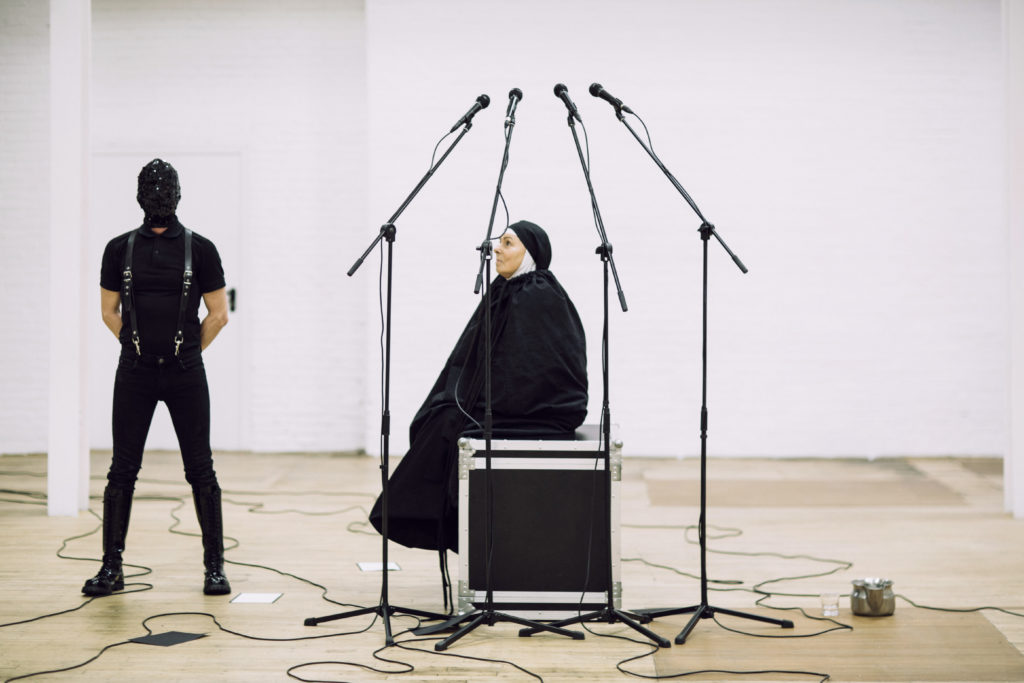
GRITOS Y SUSURROS. CONFLICTE DRAMÀTIC CINQUÈ (AMB L’OBRA D’ART) [CRIES & WHISPERS: FIFTH DRAMATIC CONFLICT (WITH THE WORK OF ART)] (2009)
This dramatization consists of a part of the concluding performance of the five that comprised GRITOS Y SUSURROS. Converses amb els radicals [CRIES & WHISPERS: Conversations with Radicals], 2009. A female interpreter wears garments of a Catholic religious order and a black leather orthopedic boot with spurs. A hooded serf character directs her reading of a script based on Éperons: Les styles de Nietzsche [Spurs: Nietzsche’s Styles], Jacques Derrida’s 1978 analysis of fellow philosopher Friedrich Nietzsche’s discordant conception of women in his work. The performer’s body is summarily moved into various positions without warning, forcing the register of her voice and her delivery of the words to compensate differently each time. In the final part, the nun character is made captive and shrouded in a black sack.
BAREBACK. FENOMENOLOGÍA DE LA COMUNIÓN [BAREBACK: PHENOMENOLOGY OF COMMUNION] (2010)
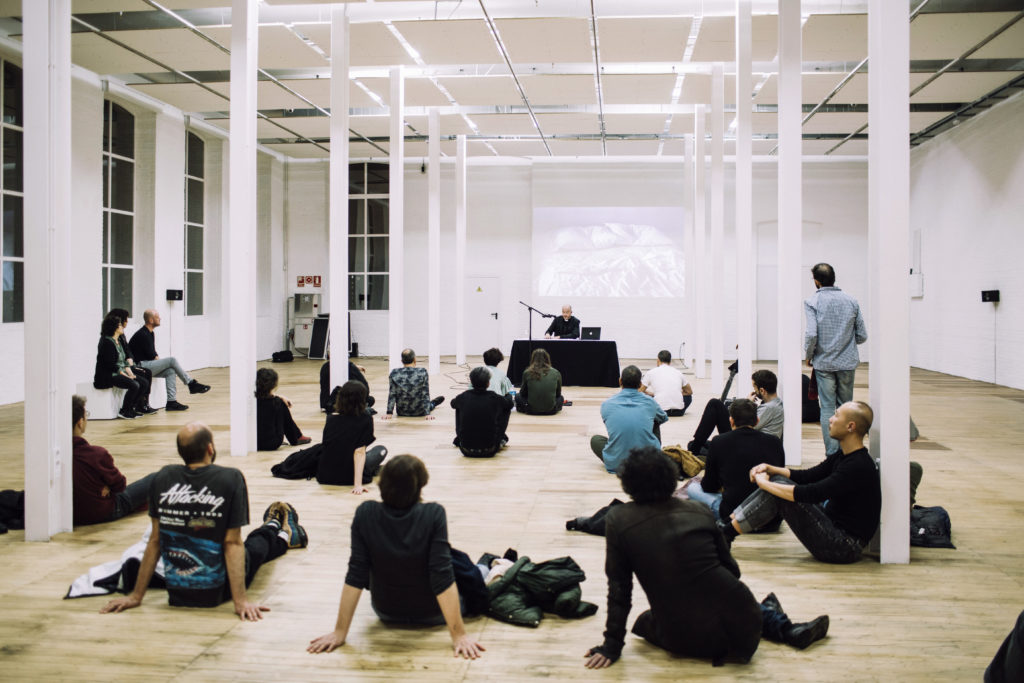
In this reading, the speaker—dressed in the clerical attire of a priest— delivers a personal and theoretical address, a form of self-reflective homily or sermon. He is accompanied by an image of a billboard showing an unmade double bed with the hollows left by two heads in the pillows. This image documents artist Félix González-Torres’ Untitled (1991), a public-art project about private loss, and a memorial to the artist’s partner who had recently died of an AIDS-related illness. The sermon comprised a series of digressions around its ostensible topic: the practice of unprotected sex and the homosexual “barebacking” subculture, in which the risk of HIV infection is considered irrelevant or even desirable.
IL LINGUAGGIO DEL CORPO. PRÒLEG [THE LANGUAGE OF THE BODY: PROLOGUE] (2015–2016)
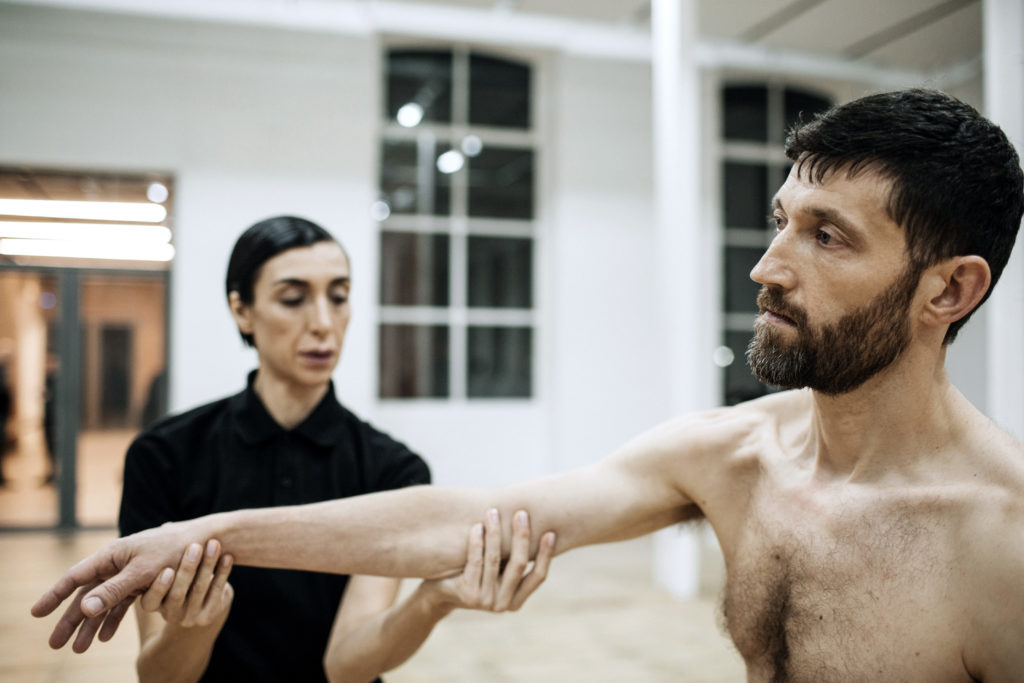
This three-hour long performance was originally presented as a preparatory study for the project IL LINGUAGGIO DEL CORPO [The Language of the Body] (2015), later developed in full by Morey during a residency at the Royal Academy of Spain in Rome. It was a tableau vivant that bridged Greco-Roman sculpture and minimalist dance. A nude male dancer adopted the dynamic, sinuous pose found in classical statuary and described by the term contrapposto [counterpoise]. At the same time, a female choreographer dressed in black stood silently reading a transcription of a radio broadcast entitled The utopian body, given in 1966 by the French philosopher Michel Foucault. At intervals the woman repositions or corrects the posture of the man by referring to images of Roman statues.
TOUR DE FORCE. EL COS UTÒPIC [TOUR DE FORCE: THE UTOPIAN BODY] (2017)
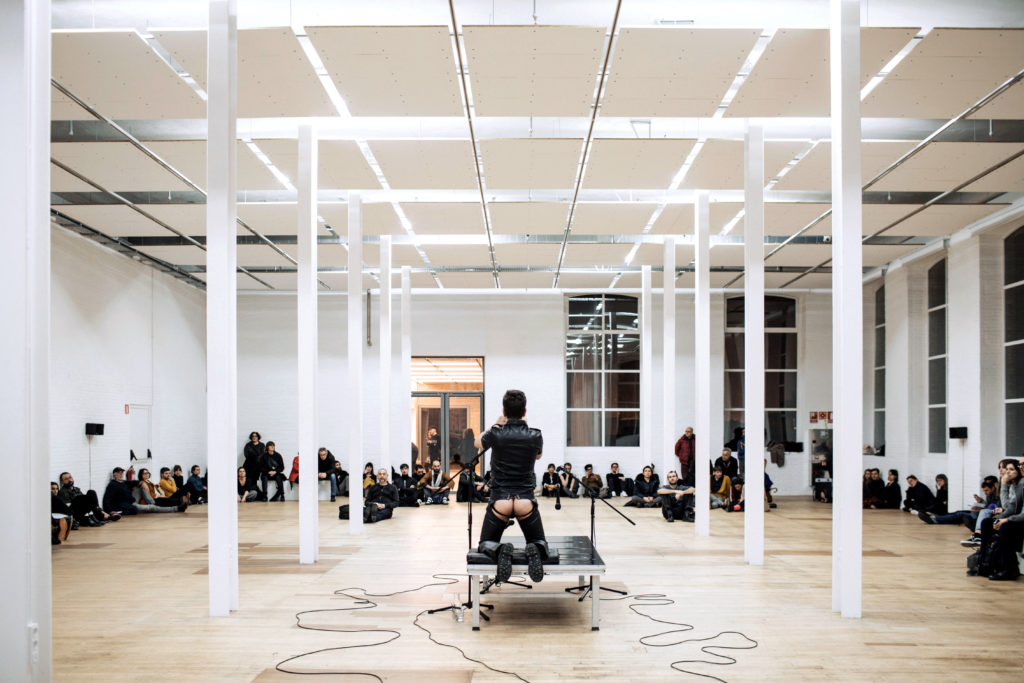
A performer dressed in black leather garments ritualistically reads from a mobile device, listing the dates since 1987 on which new antiretroviral drugs were approved for use in the United States to treat HIV/AIDS. The brand names of each of the medications joins the litany of dates, while the pill trademarks are repeated as though they are figures worthy of veneration: Saint Genvoya, Saint Stribild, Saint Odefsey, and so on. This performance, originally presented as the fifth act of TOUR DE FORCE (2017), was first witnessed by an audience of only six people in the setting of a white limousine driving through Barcelona. The project, as a whole, is comprised by a conceptual history of the HIV/AIDS pandemic—from the fear and stigma surrounding diagnosis and infection in the 1980s and 1990s, to the possibility of its management and control today via pharmaceutical compliance.
II. IL LINGUAGGIO DEL CORPO [THE LANGUAGE OF THE BODY] (2015)
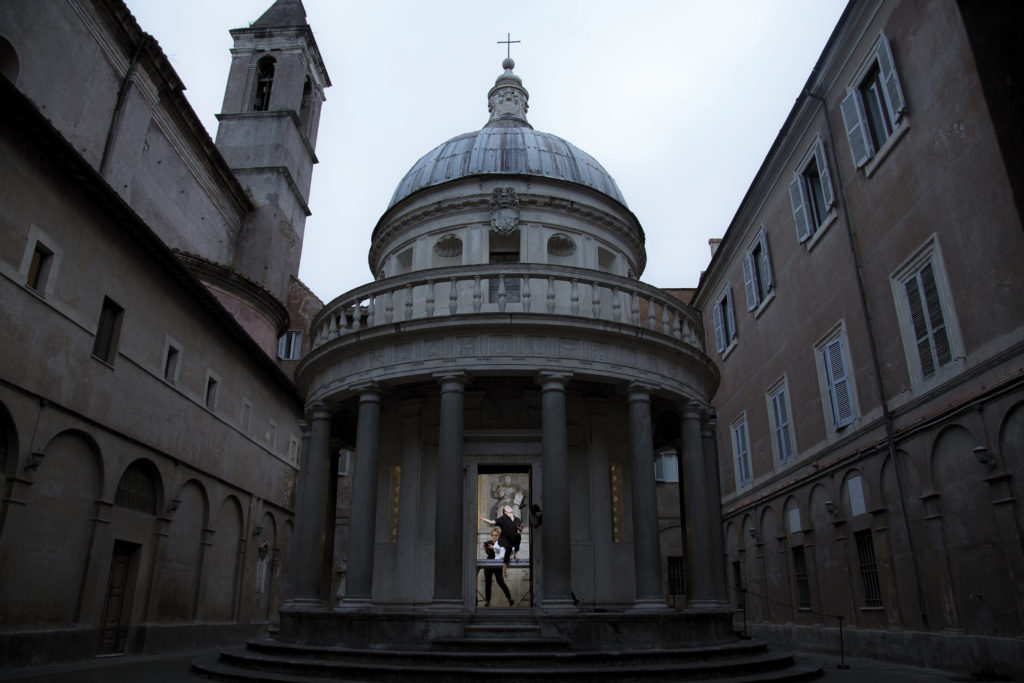
Morey’s IL LINGUAGGIO DEL CORPO (2015) was a performance in three independent acts, lasting one hour each, that took place in three spaces at the Royal Academy of Spain in Rome. It centered on the representation of the body in classical sculpture and its transferal to a live medium by translating the forms of an inert stone body, a figure impregnated with history, into the materials of living and breathing humans. Taking place behind closed doors, each performance was executed by interpreters following the instructions of the artist (who was deliberately absent on each occasion) and was documented by a film crew. The latter acted independently yet, like the interpreters, had to adhere to a manifesto in list form, which governed their behavior. This directive was based on the No Manifesto (1965), in which dancer and choreographer Yvonne Rainer pared dance down to its essence via negativa: “No to spectacle. No to virtuosity…”. The artistic direction of the project was developed in collaboration with the Italian dancer and choreographer Marta Ciappina, who oversaw the casting of the performers, created a working method for the movements of the three acts based around muscle memory and exercises of resistance, and developed the conditions by which the performers and those responsible for documentation were the only spectators.
The first act, entitled ‘Berniniana,’ transpired in the courtyard of the Church of San Pietro in Montorio, inside Bramante’s Tempietto (1510), a diminutive temple which instituted the architectural ideals of the Roman Renaissance. Inside the temple, a female interpreter (Ciappina) holds a series of poses based on Truth Unveiled by Time (1646–1652), Ecstasy of Saint Teresa (1647–1652), and Blessed Ludovica Albertoni (1671–1674), three marble sculptures of women by Gian Lorenzo Bernini, the Baroque artist renowned for his extraordinary ability to depict heightened emotion.
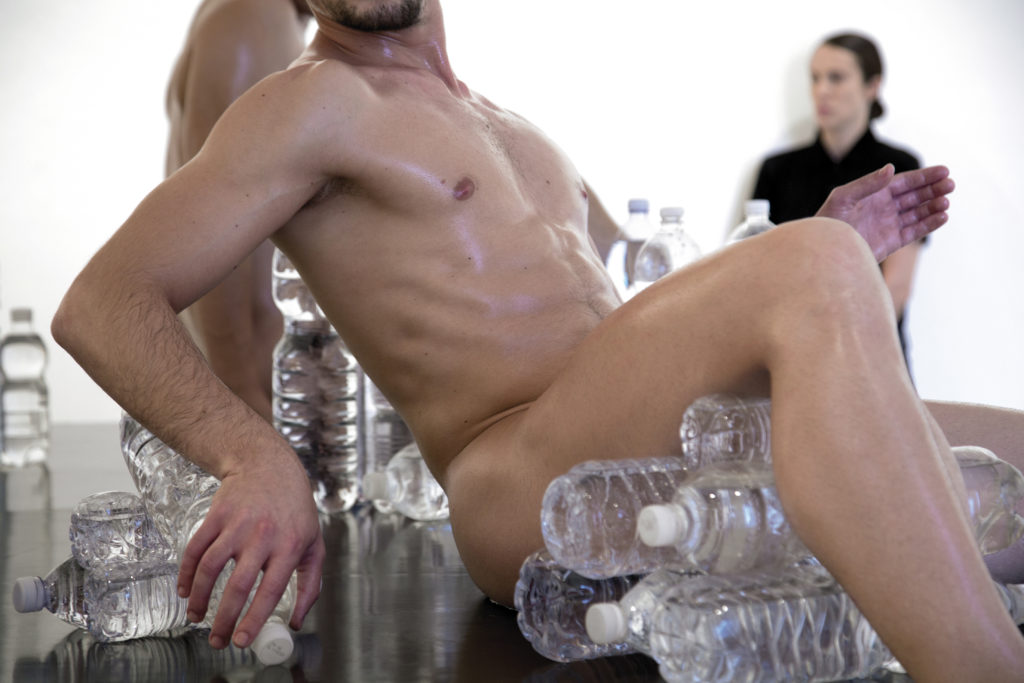
The second act, entitled ‘Le Fontane’ took place in the exhibition galleries of the Academy. Positioned on stage platforms, seven nude male interpreters enact a series of poses derived from the sea and river Gods depicted in three Roman fountains: the Fontana di Marforio, the Fontana dei Tritoni, and the Fontana dei Quattro Fiumi. Between being both actively positioned and resting, each male performer had been asked to drink from bottles of water that surrounded him. Sweating profusely under the gallery lighting in what was the heat of summer, they had been requested to urinate whenever they needed while maintaining sculptural position, becoming human fountains.
The portrait gallery of the Academy was the setting for ‘Belvedere,’ the third act. In this iteration, five nude male interpreters take turns posing upon a stool, like a statue on a plinth. Each of their poses are based on a celebrated fragmentary marble statue from the first-century BC, known as the Belvedere Torso, now within the collection of the Vatican. Each ‘human sculpture’ was then lifted and carried off the pedestal by a group of women and carefully placed horizontally on the floor on a rubber surface—rolled towels indicated stress points for the men to maintain their rigid poses.
III. MÀQUINA ESQUIZOFRÈNICA [SCHIZOPHRENIC MACHINE] (2019)
Màquina esquizofrènica [Schizophrenic machine] was the concluding performance of COLLAPSE, and took place on a freezing evening of January 2019. One hundred and thirteen pre-vetted audience members, each complying with a rigid all-black dress code, were driven by coach to a previously undisclosed location: La Model, a former prison in Barcelona’s Eixample neighbourhood.
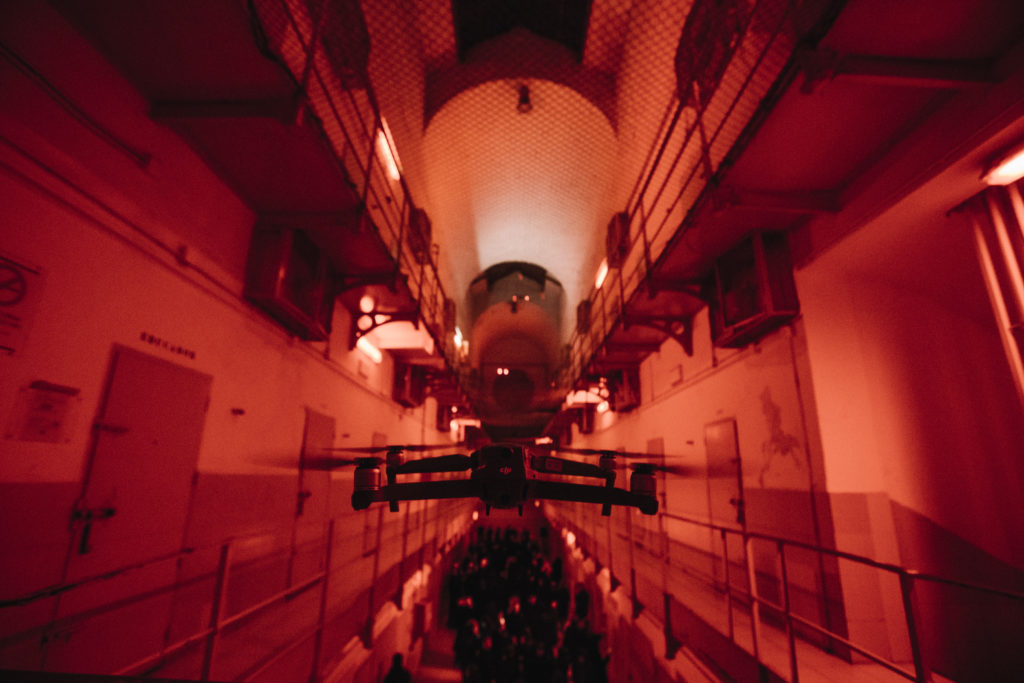
Inaugurated in 1904 and closed as recently as 2017, La Model was a notorious center for political repression and social control during the Franco dictatorship (1939–1975). Morey’s major new performance was his first with no leading human actors. Instead, a cast of drones and a high-speed camera robot arms were the technological interpreters. Or rather, the building itself became the principal character as the spectator-captives were corralled from one scene to the next, led into and out of its different wings and yard, returning each time to the central core of the correctional mechanism. Blinding lights, an architecture-scanning laser, recorded voices, and music including Klaus Nomi’s 1981 rendition of the “Cold Song” from Henry Purcell’s 1691 opera King Arthur dramatized the foreboding architecture.
With its six radial arms and central surveillance tower, La Model was built to embody the principles of the panopticon. Devised in 1791 by the English philosopher and economist Jeremy Bentham, the panopticon typology produced a device whereby a single omnipresent guard could in principal observe all inmates at the same time. The architecture generated total control of the prisoners, and supposedly instigated their redemption, by inducing an incessant state of self-monitoring and automatically guaranteeing authority over privacy. Overwhelming and unrelenting, Morey’s Schizophrenic machine was brought to an end with a deafening recording of the siren, once used to signal a prison lockdown.
